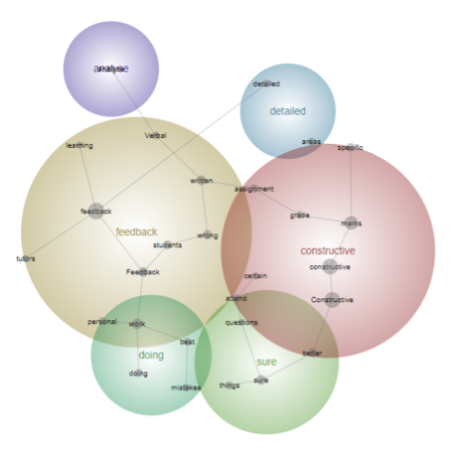
What students told us ‘good’ feedback means to them

Feedback is an important part of the learning process. However, what faculty consider good feedback might not align with what their students think. We recently surveyed a group of students to better understand their perspective on feedback so that as educators we could engage them in a discussion on the topic and enhance their learning experience.
‘What is good feedback?’
We asked nearly 300 predominantly first-year marketing students to respond to the question: “What is good feedback?”
While it was a simple, direct question, it provided us with a range of detailed responses that we believe gave us a strong indication of what students would like in their feedback. We analysed the data through a word-cloud visualisation and Leximancer software.
What students said was good feedback
Apart from the word “feedback”, the 10 most common words in students’ responses were: improve, can, constructive, work, written, better, specific, well, like and detailed.
Next, students’ open-ended responses were analysed using the text mining software Leximancer. The analysis recognises “concepts”, which are collections of words that are grouped together in the text and these concepts are clustered into higher-level “themes”. These themes are represented by balloons with concepts connected showing lines of relationships when the conceptual map is generated. The themes are ranked by “hits”, which are the number of texts associated with the theme.
This study resulted in six overall themes with 28 concepts identified. The themes and concepts were: feedback (written, wrong, students, verbal, tutors, learning); constructive (marks, assignment, specific, grade, certain); sure (better, things, questions, attend); doing (personal, best, mistakes); detailed (areas); and analyse (analyse). The table below also presents some examples.
|
|
|
Theme: Feedback (hits: 70) Concepts: feedback, work, feedback, written, wrong, students, verbal, tutors, learning Response example:
|
|
Theme: Constructive (hits: 61) Concepts: constructive, constructive, marks, assignment, specific, grade, certain Response example:
|
|
Theme: Sure (hits: 33) Concepts: sure, better, things, questions, attend Response example:
|
|
Theme: Doing (hits: 23) Concepts: doing, personal, best, mistakes Response example:
|
|
Theme: Detailed (hits: 18) Concepts: detailed, areas Response example:
|
|
Theme: Analyse (hits: 2) Concepts: analyse Response example:
|
The Leximancer analysis also includes “balloons” to visually present the themes and their relationship to the concepts. According to the visual results, the main themes are clearly “feedback” and “constructive”, yet each has relationships with two different themes. This indicates that the students want feedback that is analytical (“analyse”) and practical (“doing”), plus the constructive feedback should be clear (“sure”) and detailed (“detailed”).

Some other points that were raised by students were that while some like verbal feedback, feedback that is written is key. Also, students want the feedback to be specific to them and for it to show them how to improve, with comments focused on where their mistakes were and how to correct them; and they want to learn from the feedback and know how to improve in the future, which is emphasised by the frequency of the word “constructive”.
How should we respond to the student feedback survey?
After hearing from what students consider good feedback, how should we respond? And how can time-poor educators in particular provide personal and detailed feedback in the most effective way for students? Two potential solutions are:
Peer-based feedback
Asking students to provide feedback on what their fellow students have written, including in their assessments, is effective and improves their engagement with the course content. When we experimented with this in an online class, students posted a variety of interesting feedback and comments. Plus the peer evaluation tasks provided a range of responses which greatly helped students bond with each other and with us as the educators.
Marking rubrics
Our institution requires a marking rubric for every subject, which can be very useful in marking and providing feedback through a structured framework. A well-presented rubric can provide the student with constructive detail and a clear understanding of what was expected, where they may not have met these expectations and the reason they received their given grade. It is also given to all the students in the subject, which establishes fairness and consistency of feedback criteria across the class.
From asking a simple question: “What is good feedback?”, we have obtained a rich dataset to understand what students would like from us. Our job now is to listen and respond so that students become active partners in their learning process.
David Waller is associate professor and head of the marketing discipline group, Kaye Chan is senior lecturer in marketing, and Geetanjali Saluja is senior lecturer in marketing, all at the University of Technology Sydney.
If you would like advice and insight from academics and university staff delivered direct to your inbox each week, sign up for the Campus newsletter.


